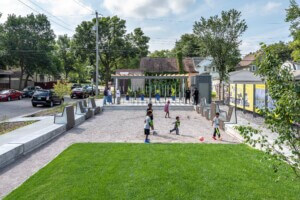Rosalie Genevro, the executive director of The Architectural League of New York since 1985, informed the board of directors earlier this week that she will step down from her post in June 2023. The League will formally announce the search for a new director in the coming weeks, with the hope of naming a new hire in time for Genevro’s departure next year.
“I have been here for 37.5 years as of now,” Genevro told AN. “The League is strong and I’m happy with what I’ve accomplished here and I’m happy to set it off to a new future.”
When asked what she plans to do next, she responded, “I would like to do some more focused work on climate change, but there’s nothing specific I’m planning on doing.”
As leader of one of the nation’s most proactive and engaged architectural associations, Genevro has been party to era-defining changes in the profession and New York City. When she joined the League in the 1980s, architecture was still in the midst of its postmodern moment—largely a white man’s club of cloistered specialists mired in arcane formal and theoretical disputes—and the city was still emerging from the white flight and financial crises that had left large swathes of its fabric derelict and abandoned. Today, the pandemic excepted, the city has roared back to economic prominence, its built environment bolstered by a jaw-dropping spate of development—much of which has been influenced by the League’s initiatives—and the profession has opened itself to increased diversity and engagement with larger issues, both social and environmental.
“Rosalie has been an untiring advocate for architecture and the built environment,” said architect and League President Mario Gooden. “Her enduring commitment to advocating for architecture’s role in promoting design ethics, social discourse, and spatial justice guided the League as it evolved into an expansive and inclusive network across the varied terrains of the building environment. She leaves a stalwart legacy for which we are immensely grateful along with the responsibility to build on that legacy for future generations of architects and designers.”
During her tenure, Genevro, an architectural historian who studied at Occidental College and Cornell University, has brought about a wide range of initiatives and programs at the League. Many of them have worked toward broadening the boundaries of the profession and providing architects—as well as activists, writers, city planners, landscape architects, graphic designers, and artists—with career-defining opportunities.
Vacant Lots, for example, a 1987 design study the League collaborated on with the New York City Department of Housing Preservation and Development, examined the potential of small-scale infill projects to increase the amount of affordable housing in the city. The study identified ten city-owned sites and tasked designers with developing plans for them that could also serve as prototypical infill solutions. Among the architects who participated were Michael Manfredi and Marion Weiss, who worked together for the first time on the study, an experience that gave rise to their practice, Weiss/Manfredi.
“Rosalie has been a seminal catalyst and conscience for the architectural community,” Marion Weiss and Michael Manfredi told AN. “Her values, and the values of the Architectural League, to create a place for robust debates on architecture, design, and urbanism continues to be an inspiration. The League’s Vacant Lots program, led by Rosalie, launched our first collaboration and set in motion our practice and trajectory of our work.”
Other design studies followed, including one on small-scale, community integrated schools; another on parks as multi-function infrastructure; and yet another investigating the architectural, financial, and programmatic possibilities of branch libraries. “Creating opportunities for architects to envision possibilities for the city that they weren’t being asked to do was part of [these initiatives],” Genevro said, “but also identifying a need and what are the different ways it could be done.”
More recently, she’s been behind a series of programs that have spurred the architectural community to do more to address the cultural changes necessary to confront climate change. Among them are Ten Shades of Green (2006), an exhibition and book curated by Peter Buchanan that showcases architectural projects that are both beautiful and sustainable; and The Five Thousand Pound Life, a far-reaching initiative that includes events, digital releases, and a national design study aimed at reimagining the American way of life into something much more ecologically attuned.
Genevro also launched the award-winning online publication Urban Omnibus, which explores the collective work of city-making; and oversaw a substantial increase in the support the League provides to students and emerging designers through mentorships, travel grants, project grants, and fellowships.
In addition to her work at the League, Genevro has served as a peer reviewer for multiple New York City agencies and as a critic and juror for countless architecture schools, grant juries, and prize competitions. She was on the inaugural juries of the Jane Jacobs award of the Rockefeller Foundation and the Women in Architecture award of Architectural Record. Genevro also received an Arts and Letters Award in Architecture from the American Academy of Arts and Letters in 2015.
“I love dealing with architects because they’re thinking about possibility and about the future,” Genevro said. “I don’t like the idea of the singular form giver who’s going to impose his or her will on other people. I do love the idea of architecture in all its necessary complexity. I was thinking about what my motivating idea is, how I think about architecture and building and the city. The words that came to mind are, ‘Thick, Rich, and Deep.’ They’re words that speak to the enormous complexity and plurality, the multiple points of view, all the things that have to be taken in and held in balance to produce something that’s good and useful to all kinds of people. That is what’s appealing about the idea of architecture and cities and settlement in general.”











